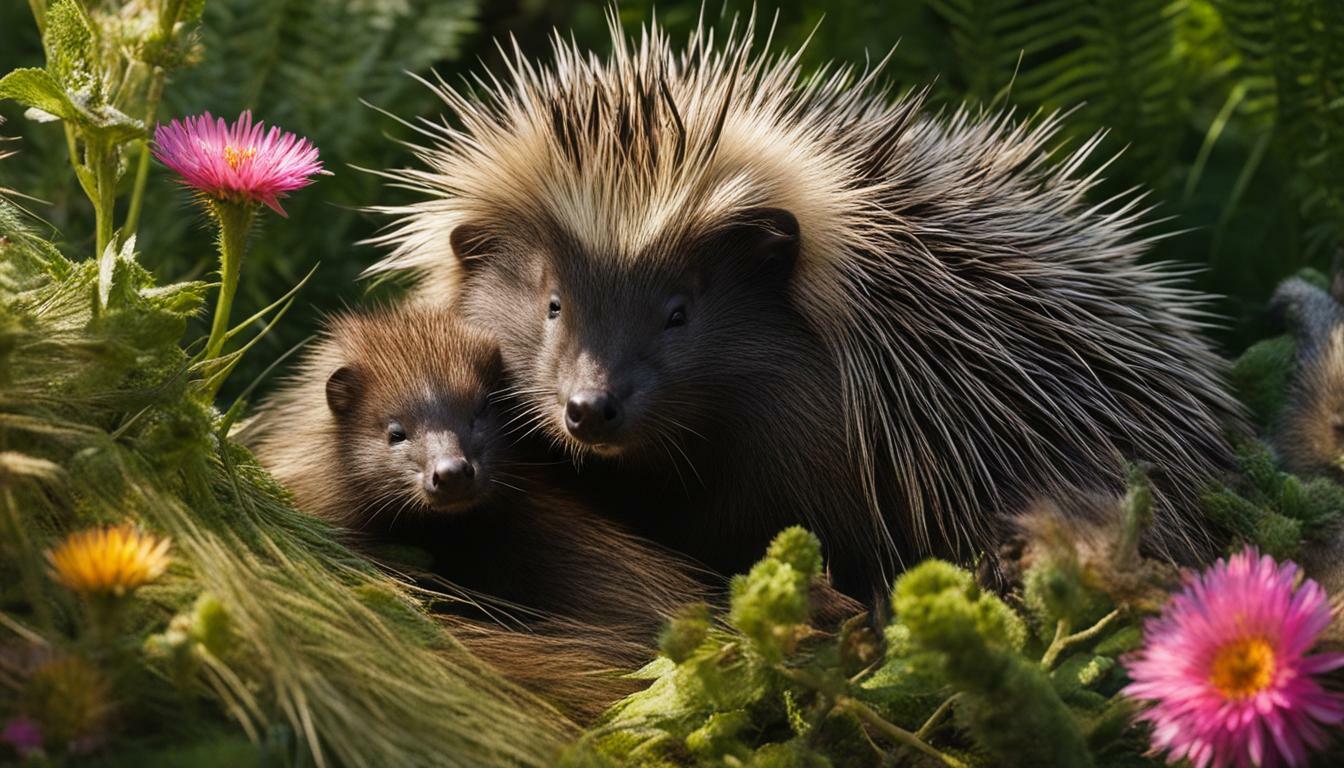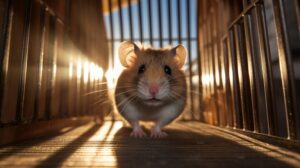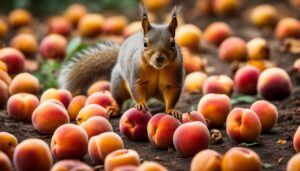Porcupines are fascinating animals known for their quills, but are they actually born with these sharp spines? In this article, we will explore the world of porcupine quills and uncover the truth about their presence from birth. From their formation to their role in defense, we will delve into the intriguing journey of these unique creatures.
Key Takeaways:
- Porcupines are born with soft quills that harden within minutes after birth.
- The quills of newborn porcupines are similar to those of their parents in structure, except for length.
- Quills cover the entire body of a porcupine, except for the underbelly and the underside of the tail.
- Porcupine quills serve as a defense mechanism, with the ability to stick into a predator’s skin when the porcupine strikes its tail.
- Quills are continuously replaced if lost, and shedding is a natural process for porcupines.
- Porcupines have an average lifespan and their quills have cultural significance, often used in artwork and jewelry.
Porcupine Quill Formation
Understanding the formation of porcupine quills is key to unraveling the mystery of whether porcupines are born with these unique defensive spines. When a porcupine is born, it already has soft quills covering its body. These quills, although pliable at birth, quickly begin to harden within minutes. The process of quill formation is fascinating and plays a crucial role in the porcupine’s survival.
Similar to the quills of adult porcupines, the quills of a newborn porcupine are made of keratin, the same material found in our own hair and nails. These quills grow from specialized hair follicles embedded in the porcupine’s skin, and their growth is a continuous process throughout the porcupine’s life.
Porcupette, as newborn porcupines are called, have quills covering their entire body, except for the underbelly and the underside of their tail. These soft quills provide some protection, but they are not yet capable of inflicting the same level of damage as the hardened quills of an adult porcupine. However, even at a young age, porcupines possess the instinct to defend themselves and can use their tails to strike predators, embedding their quills into the predator’s skin.
Quill replacement and shedding are natural processes in a porcupine’s life. If a porcupine loses some quills, new ones will grow to replace them. This ensures that the porcupine maintains its defense mechanism throughout its lifetime. Additionally, porcupines have an average lifespan, during which their quills play a crucial role in protecting them from predators and ensuring their survival.
| Porcupine Quill Formation | Porcupine Quill Replacement | Porcupine Lifespan |
|---|---|---|
| Quills harden within minutes after birth | Quills are replaced if lost | Porcupines have an average lifespan |
| Quills made of keratin | New quills grow from specialized hair follicles | Quills play a role in protecting porcupines from predators |
| Soft quills cover the whole body, except underbelly and tail | Quill replacement ensures defense mechanism | Quills are used in artwork and jewelry |
The Quills of Newborn Porcupines
When porcupines are born, their quills are quite different from those of their parents, but how exactly do these newborn quills look and function? Let’s explore the fascinating world of porcupine quills and the unique characteristics of the quills found on baby porcupines.
Unlike the hardened quills of adult porcupines, the quills of newborns are soft and flexible. These soft quills serve as a form of protection for the vulnerable young porcupettes. While they may lack the sharpness and length of adult quills, these flexible spines still possess the ability to deter potential predators.
The quills are distributed all over the baby porcupine’s body, with the exception of the underbelly and the underside of the tail. This strategic placement ensures that when the porcupine strikes its tail at an attacker, the sharp quills are more likely to make contact and embed into the predator’s skin.
As the newborn porcupine grows, its quills gradually harden, becoming sharper and more formidable. This gradual hardening process allows the young porcupine to develop a reliable defense mechanism, protecting itself from threats in its environment.
| Quill Characteristics | Function |
|---|---|
| Soft and flexible | Provides some form of defense for vulnerable newborn porcupines |
| Distributed all over the body | Ensures effective quill contact with predators when the porcupine strikes its tail |
| Gradually harden with growth | Develops into formidable defensive weapons as the porcupine matures |
It is important to note that porcupines have the ability to replace lost quills, and shedding is a natural process for them. This allows them to maintain their defense mechanism throughout their lifetime. Additionally, porcupines have an average lifespan and their quills have been utilized in various forms of art and jewelry, showcasing the cultural significance of these unique spines.
The Growth and Hardening Process
The growth and hardening process of porcupine quills is a fascinating phenomenon that occurs within minutes after a porcupine is born. These soft, flexible quills quickly transform into the formidable defensive weapons that porcupines are known for. The quills of a newborn porcupine are remarkably similar to those of its parents, with the main difference being their shorter length.
The porcupette is covered in quills all over its body, providing it with an effective defense against potential predators. However, the underbelly and the underside of the tail are not covered in quills, making these areas more vulnerable. The remarkable feature of porcupine quills is their ability to stick into an attacker’s skin when the porcupine strikes its tail, which acts as a weapon in self-defense.
If a porcupine loses any quills, they are replaced through a natural process of growth and shedding. As the quills age, they become more brittle and may break or fall out. However, new quills will grow in their place. This continuous replacement ensures that the porcupine maintains a strong defense mechanism throughout its lifetime.
| Key Points | |
|---|---|
| Porcupine quills grow and harden within minutes after birth. | |
| Quills cover the entire body of a porcupine, except for the underbelly and the underside of the tail. | |
| Quills can stick into a predator’s skin when the porcupine strikes its tail. | |
| Quills are replaced if lost and shedding is a natural process. | |
| Porcupines have an average lifespan and their quills are used in artwork and jewelry. |
Quill Distribution on a Porcupine’s Body
Quills cover a porcupine’s body, but are there any specific areas where these spines are not present? Let’s explore the distribution of quills on a porcupine’s anatomy. Porcupines have long, sharp quills that act as a powerful defense mechanism against predators. These spines are made of keratin and are similar to human hair in composition.
The quills are found all over the porcupine’s body, including the head, back, sides, and tail. However, there are a few areas where these sharp needles are absent. The underbelly and the underside of the tail are devoid of quills. This unique distribution pattern allows the porcupine to defend itself effectively by exposing these areas to predators while protecting the rest of its body with a formidable quill barrier.
It is important to note that porcupines have different types of quills depending on their location. The longer quills on the back and tail serve as the primary defense mechanism, while the shorter quills on the head and sides provide additional protection. This strategic arrangement ensures maximum coverage and increases the porcupine’s chances of deterring potential threats.
The Distribution of Porcupine Quills
| Body Part | Quill Distribution |
|---|---|
| Head | Quills present |
| Back | Quills present |
| Sides | Quills present |
| Underbelly | No quills |
| Tail | Quills present (underside devoid of quills) |
“The distribution of quills on a porcupine’s body is a fascinating adaptation to ensure maximum protection. While the underbelly and the underside of the tail are vulnerable areas, the presence of quills everywhere else creates an impenetrable shield. It’s fascinating to see how nature has equipped these remarkable creatures with such a unique defense mechanism.”
In summary, porcupines have an impressive distribution of quills on their bodies, with the exception of the underbelly and the underside of the tail. These sharp spines serve as a powerful defense mechanism, deterring predators and keeping the porcupine safe. By understanding the distribution and purpose of porcupine quills, we can appreciate the remarkable adaptability of these fascinating creatures.
Porcupine Quill Replacement and Shedding
Porcupines rely on their quills for protection, but what happens when they lose or shed these spines? As fascinating as their quills are, they are not forever. Porcupines have a natural process of quill replacement and shedding, ensuring they always have a defense mechanism at their disposal.
When a porcupine loses a quill, whether in a confrontation with a predator or during everyday activities, a new one grows in its place. The process of quill replacement is continuous throughout a porcupine’s life. As the old quill falls out, a new one begins to grow from the same follicle. It takes time for the new quill to fully develop and harden, but within a few weeks, it becomes a formidable yet flexible spine.
Shedding is another interesting aspect of porcupine quills. Just like humans shed hair, porcupines shed their quills. This shedding process ensures that old and worn-out quills are replaced with fresh ones. The shedding frequency varies among individuals, but on average, porcupines shed their quills once a year.
It is worth noting that quill shedding is not a painful process for porcupines. The old quills naturally loosen and fall off, making way for the new ones. This shedding cycle ensures that porcupines maintain their protective armor, allowing them to defend themselves against potential threats in their environment.
Porcupine Quill Replacement and Shedding Table
| Process | Frequency |
|---|---|
| Quill Replacement | Continuous |
| Quill Shedding | Once a year (on average) |
The Lifespan of Porcupines
Understanding the lifespan of porcupines is essential in comprehending the longevity of their quills as a defense mechanism. Porcupines typically live for around 10 to 15 years in the wild, although some have been known to reach the impressive age of 20 years. This relatively long lifespan allows them to protect themselves and their offspring using their unique quills throughout their lives.
Porcupines are born with soft quills that quickly harden within minutes after birth. While there is not much difference between the quills of a newborn porcupine and those of its parents, the main distinguishing factor is the length. The tiny porcupette is covered in quills all over its body, offering immediate protection from potential predators.
The distribution of quills on a porcupine’s body is strategic. Quills can be found on the porcupine’s back, sides, and tail, forming a formidable defense mechanism. When threatened, the porcupine may strike its tail at the predator, causing the quills to embed into their skin. This can result in pain, discomfort, and even injury for the attacker, serving as a strong deterrent against future attacks.
Quill replacement and shedding are natural processes for porcupines. If a quill is lost or damaged, a new quill will grow in its place. This ensures that the porcupine always has a full set of quills at its disposal. Shedding occurs regularly to maintain the health and vitality of the quills. As the porcupine’s quills grow, it sheds the older, worn-out ones, allowing for the continuous development of strong and effective defensive spines.
| Lifespan | Quill Formation | Quill Distribution | Quill Replacement |
|---|---|---|---|
| 10-15 years | Soft quills harden within minutes after birth | Quills cover the entire body, excluding the underbelly and underside of the tail | Lost or damaged quills are replaced, shedding occurs regularly |
Porcupine Quills in Art and Jewelry
Porcupine quills have found their way into human culture, being used in artwork and jewelry, but what makes them so desirable? These unique and beautifully patterned quills possess a natural allure that has captivated artists and craftsmen for centuries. Their versatility and striking appearance make them a popular choice for creating stunning pieces that showcase the beauty of nature.
Artists and artisans use porcupine quills in a variety of ways, incorporating them into paintings, sculptures, and mixed media artworks. The quills’ intricate patterns and rich colors add depth and texture to the artwork, creating visually captivating pieces. Their naturally tapered shape allows artists to create fine lines and detailed designs with ease, further enhancing the artistic possibilities.
The use of porcupine quills in Native American art is particularly notable, with indigenous tribes employing them as decorative elements in traditional clothing, baskets, and ceremonial regalia. These quills are meticulously dyed in various colors, allowing artists to create intricate patterns and designs that hold deep cultural and spiritual significance.
In the realm of jewelry, porcupine quills are prized for their unique and exotic appeal. They are often incorporated into earrings, necklaces, bracelets, and even hair accessories, adding a touch of nature-inspired elegance to any ensemble. The quills’ lightweight and durable nature make them comfortable to wear and easy to incorporate into various jewelry designs.
The Beauty of Porcupine Quill Structure
Porcupine quills are composed of keratin, the same material found in human hair and nails, giving them strength and flexibility. The quills’ structure consists of a solid, hollow core with tiny barbs along the sides, which allow them to latch onto the skin or fur of an attacker, making their removal challenging and painful.
| Key Features of Porcupine Quill Structure | |
|---|---|
| Composition | Keratin |
| Core | Solid and hollow |
| Surface | Smooth with tiny barbs |
| Color | Naturally varied |
Porcupine quills, with their beauty and distinctive characteristics, have become highly sought after by collectors and enthusiasts alike. Whether cherished for their cultural significance, artistic appeal, or unique aesthetic, these quills continue to captivate and inspire the creative world.
Conclusion
The journey of porcupines and their quills has taken us through their formation, functionality, and cultural significance, revealing the remarkable nature of these spiny animals. Porcupines are born with soft quills that harden within minutes after birth. There is not much difference between the quills of a newborn porcupine and those of its parents, except for length. The porcupette has quills all over its body, except for the underbelly and the underside of its tail.
Quills are not just an aesthetic feature; they serve a crucial purpose in the survival of porcupines. These sharp spines are used as a defense mechanism, capable of sticking into a predator’s skin if the porcupine strikes its tail. This natural armor provides efficient protection against potential threats.
Porcupines have an incredible ability to replace any lost quills, ensuring the continuity of their defense mechanism. Shedding is a natural process that allows for the growth of new quills and the removal of old ones. This ongoing cycle helps them maintain their defensive capabilities throughout their lifetime.
Beyond their practical functionality, porcupine quills hold cultural significance. They have been utilized in various forms of art and jewelry, showcasing the beauty and craftsmanship that can be derived from nature’s creations. The unique texture and appearance of porcupine quills make them a popular choice for decorative purposes, capturing the imagination of artisans and enthusiasts alike.
Overall, the journey through the realm of porcupines and their quills has exposed us to the wonders of nature’s ingenuity. From their formation to their vital role in defense, and their cultural value, porcupine spines are a testament to the remarkable adaptability of these extraordinary creatures.
FAQ
Are porcupines born with quills?
Yes, porcupines are born with soft quills that harden within minutes after birth.
What is the difference between the quills of a newborn porcupine and those of its parents?
There is not much difference between the quills of a newborn porcupine and those of its parents, except for length.
Where are the quills located on a newborn porcupine’s body?
The porcupette has quills all over its body, except for the underbelly and the underside of its tail.
How are quills used as a defense mechanism?
Quills can stick into a predator’s skin if the porcupine strikes its tail, serving as a deterrent.
Can porcupines replace lost quills?
Yes, quills are replaced if lost, and shedding is a natural process.
What is the average lifespan of porcupines?
Porcupines have an average lifespan, which varies depending on factors such as environment and species.
How are porcupine quills used in artwork and jewelry?
Porcupine quills have been historically used in various forms of art and jewelry due to their intricate structure and unique appearance.




